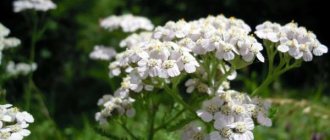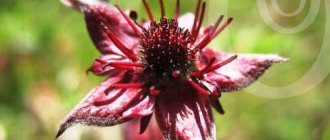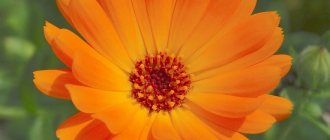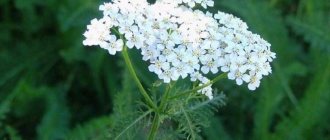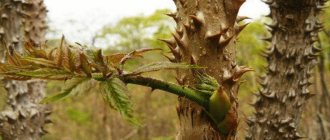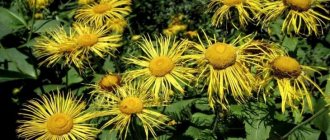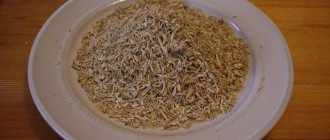Many people underestimate herbal treatment, considering plant components to be ineffective against diseases. However, an unsuccessful combination of St. John's wort with synthetic drugs or other herbal preparations can lead to serious negative reactions, worsening the patient's condition. When used judiciously, St. John's wort has a therapeutic effect on the functioning of the biliary tract, alleviates the patient's condition with gastritis, and can promote recovery from liver diseases.
What does St. John's wort treat?
The two main areas of use of St. John's wort are diseases of the digestive system and skin wounds. Systemic use of decoctions and tinctures can act as an antispasmodic for pain in the intestines, bile ducts and vasoconstriction. In addition, the herb stimulates blood circulation and reduces the level of inflammation of the mucous membranes of the gastrointestinal tract. St. John's wort is active against bacteria - it prevents them from multiplying, nullifying the course of the disease.
The use of St. John's wort has a positive effect with early initiation of treatment for flatulence, as well as with exacerbation of chronic colitis, intestinal disorders, and diagnosed biliary dyskinesia.
In relation to the treatment of urolithiasis, St. John's wort is effective as a diuretic. Due to its diuretic properties, it increases the volume of urine produced, thereby helping to remove small stones from the body.
St. John's wort tincture can be used for helminthic infestations - enterobiasis. And medications using plant extract are prescribed to patients with weak capillary walls, as well as with impaired peripheral circulation.
There is probably no such disease that they would not try to treat with St. John's wort. People say: “Just as you can’t bake bread without flour, you can’t cure a person without St. John’s wort.” This plant has many names - St. John's wort, St. John's wort, St. John's wort, St. John's wort, St. John's wort, St. John's wort, St. John's wort, St. John's wort, field pharmacy.
The generic name “Nurericum” is derived from two Greek words: “huro” - under and “ereike” - heather; it turns out “growing under heather”, or “resembling heather”. The name “perforatum” - perforated or perforated - the plant received because of the small transparent containers scattered throughout the leaf blade.
The most famous name of the herb “St. John’s wort” comes, according to some assumptions, from the Kazakh “dzherabai”, meaning “healer of wounds”, according to others - due to the ability of St. John’s wort to cause disease in sheep. Moreover, not all animals fed with St. John's wort get sick, but only white or variegated ones, and only on a bright sunny day. Swellings form on the head of such animals, growing into ulcers, and severe itching appears. But, as soon as a sick sheep moves into the shade, after a while all painful phenomena disappear. It turns out that St. John's wort contains substances (hypericin and other condensed anthracene-derivative glycosides) that increase skin sensitivity to ultraviolet rays.
In the old days, St. John's wort was considered a magical plant. In rural areas, when stuffing children's mattresses, they always added St. John's wort to the straw so that the smell of this plant would protect the child from fright in his sleep. St. John's wort was a favorite remedy of Paracelsus, used against spirits hostile to man. He wrote: “The veins on its leaves are signatures. If they are pierced, this means that the plant drives away all the ghosts around the person. ... Nurericum (St. John's wort) is an almost universal medicine.” There is also a mention of St. John's wort in Ayurveda: “Its nature is hot and dry in the second degree. St. John's wort has a cleansing, drying and resolving effect.” St. John's wort was considered a medicinal plant in both Ancient Greece and Rome. Hippocrates, Dioscorides and Pliny the Elder wrote about him. Avicenna recommended “drinking it for forty days in a row to cure inflammation of the sciatic nerve; and take the seed internally to stop the fever.” In Kievan Rus, St. John's wort was considered a herb for 99 diseases. By order of Tsar Michael, St. John's wort was collected in Siberia, dried, ground into flour and sent to Moscow “by the pound for every year.”
St. John's wort is a perennial herbaceous plant of the St. John's wort family, 30–100 cm high. The stems are smooth, round, with two lateral ribs, branched at the top. The rhizome of St. John's wort is thin, highly branched. Leaves with numerous translucent light and black glands. On examination they appear to be punctured. St. John's wort blooms from June to August. The flowers are collected in an inflorescence. The petals are bright yellow. The fruit of St. John's wort is a three-lobed capsule. The seeds are small, oblong, brown. St. John's wort is distributed throughout almost the entire European part of Russia, the Caucasus, Western and Eastern Siberia, as well as in the mountains of Central Asia. It grows in dry meadows, hills, clearings and forest edges, in sparse forests and among bushes. It is found as a weed near roads and along the edges of fields.
The name “St. John's wort” is explained by the small black dots that cover the flowers and leaves. We are not talking about holes, but about small glands filled with a red dye - hypericin. When collected independently, this is a sure sign of identification of St. John's wort: if you rub a flower or bud between your thumb and forefinger, they will turn dark red. Hypericin is especially necessary for the treatment of depression, stress, and nervous breakdowns; it does not have any side effects on the central nervous system.
St. John's wort herb is harvested in the flowering phase of the plant (before the appearance of unripe fruits), cutting off the leafy tops without the rough bases of the stems.
The main active ingredients of the herb St. John's wort are condensed anthracene derivatives - hypericin and pseudohypericin. Their number is about 0.5%. Hypericin and pseudohypericin are accompanied by resinous substances, the content of which reaches up to 17%. St. John's wort herb contains flavonoid glycosides of the flavonol group: rutin, quercitrin, hyperoside, myricetin, leukoanthocyanidins and anthocyanins (5–6%). The hyperoside content in the grass reaches 1.0–1.2%. Along with anthracene and flavonol derivatives, St. John's wort contains tannins (up to 10%), essential oil (0.2–0.3%), saponins, ascorbic acid, carotene (up to 55 mg/100 g).
St. John's wort preparations have astringent, anti-inflammatory, antiseptic and tissue regeneration stimulating properties. Medicinal preparations from St. John's wort have a beneficial effect on the functional state of the central and autonomic nervous system. Bioflavonoids contained in St. John's wort bind to benzodiazepine receptors and have a sedative effect. The drugs improve mood, increase mental and physical performance, and normalize sleep. The antidepressant effect is due to the ability to inhibit the reuptake of serotonin, norepinephrine and dopamine; St. John's wort preparations do not have contraindications and side effects, which become constant companions of chemical antidepressants.
Infusions, tinctures and extracts are obtained from the herb St. John's wort. The drugs Novoimanin, Negrustin, St. John's wort, Gelarium Hypericum, Deprim, Deprim forte are registered on the market. St. John's wort herb is included in the herbal mixtures “Brusniver” and “Brusniver-T”, “Arfazetin”, “Mirfazetin”, etc.
St. John's wort infusion (10 g per 200 ml) is used as an astringent, disinfectant and anti-inflammatory agent orally for diseases of the gastrointestinal tract, acute and chronic colitis of non-bacterial origin. Take 100 ml orally 3 times a day before meals for 1–2 months.
St. John's wort tincture and the drug Novoimanin have an antimicrobial and anti-inflammatory effect. Inhibits the growth of predominantly gram-positive microorganisms, such as Streptococcus pyogenes and Streptococcus agalactiae, penicillin-resistant Staphylococcus aureus and methicillin-resistant Staphylococcus aureus. Indicated for abscesses, phlegmon, infected wounds, burns (I–III degree), trophic ulcers, pyoderma, mastitis, rhinitis, pharyngitis, sinusitis.
St. John's wort tincture in 40% alcohol (1:5) is used as an astringent and anti-inflammatory agent in dentistry (40–50 drops 3–4 times a day) and for rinsing (30–40 drops in half a glass of water).
Novoimanin is used externally, in the form of a solution for wet dressings, rinsing cavities, electrophoresis, inhalations and drops (external auditory and nasal canal); Before use, the alcohol solution is diluted 1: 5–10–25–100 with sterile distilled water, a sterile 10% dextrose solution or a 0.25% procaine solution. Solutions obtained by diluting a 1% alcohol solution are suitable for use during the day. During the treatment period, care must be taken when driving vehicles and engaging in potentially hazardous activities that require increased concentration and speed of psychomotor reactions.
Medicines based on St. John's wort concentrate are indicated for the treatment of mild and moderate depression. They have antidepressant, anxiolytic and sedative effects. Negrustin is taken 1 capsule 1-2 times a day or 1 ml of oral solution 3 times a day (undiluted or with a small amount of water with meals) for 6-8 weeks. St. John's wort is prescribed 1-2 tablets 3 times a day for at least 3 weeks, it is possible to increase the duration of treatment to 3 months (no more). Gelarium Hypericum is used 1 tablet 3 times a day for at least 4 weeks, Deprim - 1 tablet 3 times a day for 4-6 weeks, Deprim Forte - 1 capsule 1-2 times a day for 4-6 weeks
For all its popularity, St. John's wort is far from harmless. It should not be used for a long time in case of arterial hypertension and severe depression. It is contraindicated in childhood (under 12 years), during pregnancy and lactation. Even in healthy people, drinking large amounts of strongly brewed St. John's wort tea can cause symptoms of acute gastritis (nausea, pain in the epigastric region, dry oral mucosa, diarrhea or constipation), and in those suffering from hyperacid gastritis or gastric ulcer, severe overdose may occur. spasms and pain in the intestines. Amino acids, trictophan and tyrosine, amphetamines, monoamine oxidase inhibitors, antidepressants should not be used simultaneously with St. John's wort (the interval between doses should be at least 14 days). When used together with fluoxetine, paroxetine, sertraline, fluvoxamine or citalopram, St. John's wort aggravates hemolytic reactions and the course of “serotonin syndrome” (increased sweating, tremor, dizziness, nausea, vomiting, headache, epigastric pain, restlessness, anxiety, state of confusion, confusion , anxiety and irritability).
On the part of the hematopoietic organs, an overdose can cause iron deficiency anemia. St. John's wort increases the skin's sensitivity to ultraviolet rays, so after drinking tea or herbal infusion, you must refrain from sunbathing and avoid being in the sun. If this rule is violated, St. John's wort can cause sunburn of the skin, eczema, skin pigmentation and even severe dermatitis. They are especially difficult for blondes and people with delicate skin that does not take well to tanning. In case of chronic intoxication, UV radiation should be avoided for 1–2 weeks.
St. John's wort preparations can enhance the photosensitizing effect of other drugs: tetracyclines, sulfonamides, thiazide diuretics, quinolones, piroxicam, etc. They prolong sleep caused by drugs for general anesthesia and narcotic analgesics, but shorten sleep caused by barbiturates. St. John's wort reduces the hypotensive effect of reserpine and reduces the concentration of cyclosporine in the blood. St. John's wort reduces the concentration of indinavir in the blood, increases the rate of metabolism of theophylline, reducing the concentration of digoxin in the blood, and reduces its effectiveness. When used simultaneously with ethinyl estradiol and desogestrel, the risk of breakthrough bleeding increases.
During treatment with St. John's wort, it is necessary to refrain from drinking ethanol-containing drinks and avoid UV radiation (including solarium, UV lamps, prolonged exposure to sunlight) for 1–2 weeks.
Beer, coffee, wine, chocolate, smoked or pickled foods, and yoghurt do not go well with St. John's wort.
St. John's wort is widely used in homeopathy. The whole flowering plant is used to prepare the homeopathic remedy Hypericum. It is given to alleviate the condition after a concussion, depression of various natures and nerve pain after injuries.
In folk medicine, as in official medicine, St. John's wort is used primarily for the treatment of wounds and pain, in the treatment of diseases of the lungs, stomach, intestines and gall bladder, for diarrhea and nervous disorders. They use tea, oil, and alcohol extract (tincture) in equal measure, which is used to disinfect wounds.
The popular name “Ivan's grass” is associated with the fact that St. John's wort begins to bloom on Midsummer's Day, and the name “Ivan's Blood” is associated with the legend of the death of John the Baptist. When Herod killed John the Baptist, several drops of blood fell to the ground and grass grew in that place, absorbing John’s blood. This herb is St. John's wort. The leaves and petals of St. John's wort actually contain a bright red pigment that looks like blood.
Information about the authors: Samylina Irina Aleksandrovna – Doctor of Pharmaceutical Sciences, Professor, Corresponding Member of the Russian Academy of Medical Sciences, Director of the Research Institute of Pharmacy; Head of the Department of Pharmacognosy, First Moscow State Medical University named after. THEM. Sechenov. Tel.; Sorokina Alla Anatolyevna – Doctor of Pharmaceutical Sciences, Professor of the Department of Pharmacognosy of the First Moscow State Medical University named after. THEM. Sechenov. Tel.; Pyatigorskaya Natalya Valerievna – Candidate of Pharmaceutical Sciences, Associate Professor, Deputy Director of the Research Institute of Pharmacy for Scientific Work of the First Moscow State Medical University named after. THEM. Sechenov. Tel.
Is it worth taking St. John's wort for vitiligo?
Studies of the plant have shown that St. John's wort has photosensitizing properties. Together with hypericin, these properties have shown to be effective in the treatment of vitiligo. This disease develops against the background of autoimmune processes and stress, as a result of diseases of the internal organs, due to which the level of melanin in the skin, which is responsible for the color of the epidermis, is significantly reduced. The use of St. John's wort helps restore immunity by improving the functioning of the digestive system and reducing the level of free radicals.
In addition, if St. John's wort juice is applied to areas of skin with a deficiency of pigment, and the treated areas are exposed to direct sunlight, then there is a high probability of accumulation of melanin in skin cells, which can reduce the severity of uneven color.
Why is St. John's wort dangerous?
The first and main danger of St. John's wort is its incompatibility with many medications..
It has been established that St. John's wort can disrupt the metabolism of drugs in the liver - this leads to a change in their activity or the appearance of dangerous side effects. Serious consequences can result from taking St. John's wort with most antidepressants, immunosuppressants, anticoagulants (drugs to reduce blood clotting), medications for high blood pressure and heart failure. It is highly undesirable to take St. John's wort together with antibiotics: this not only reduces their effectiveness, but also has a toxic effect on the liver.
It is very important to know often, in an attempt to recover faster from seasonal acute respiratory infections/ARVI, we try to supplement the drug prescribed by the doctor with some kind of herbal treatment, believing that it certainly will not harm us - and out of ignorance we harm ourselves.
St. John's wort should not be used by women taking hormonal contraceptives: this reduces their effectiveness and can lead to bleeding and unwanted pregnancy.
The interaction of St. John's wort with various medications has not been fully studied, so if you are taking any medications not included in the list above, you should not assume that it is safe. The effect of St. John's wort on hepatic metabolism is potentially dangerous in combination with any medicine, so for your own sake it is better not to check for yourself its compatibility with your specific medications - even if these are banal multivitamins.
In herbal medicine, infusions, extracts and preparations with St. John's wort are used.
It is also known that large doses of St. John's wort have a mutagenic effect on sperm and eggs , so treatment with St. John's wort should be avoided if you plan to become parents in the near future.
St. John's wort is also incompatible with alcohol - it is better to avoid alcohol during the period of treatment with St. John's wort. If you take St. John's wort, you should be careful when driving a car, as well as any activity that requires self-control and quick reaction: the sedative (calming) effect of St. John's wort in such a situation can be dangerous to life and health.
St. John's wort is also strictly contraindicated for pregnant women and children.
The insidiousness of St. John's wort also lies in this: due to the easy attitude to “herbs” as something harmless, patients often forget to tell the doctor that they took/are taking St. John’s wort. As a result, the doctor cannot understand the cause of the patient’s deterioration, and the patient does not receive correct and timely treatment.
Fragrant tea with St. John's wort is not useful for everyone
How to take St. John's wort for depression
St. John's wort has the ability to regenerate cells of the nervous system, which improves sleep, relieves anxiety and eliminates constant psychological discomfort.
St. John's wort as a remedy for depression is taken as part of an herbal mixture, a tablespoon of which is steamed in 200 ml of hot water. The resulting drink is drunk half an hour before bedtime. The duration of therapy is from 1 month, in accordance with the doctor’s recommendations. This decoction is useful not only for depressive disorders, but also for mental stress.
St. John's wort: medicinal properties
Due to its high content of useful substances, St. John's wort can be used both as a medicine in the form of a decoction and as regular tea. But, before using this herb, it is still necessary to familiarize yourself with its medicinal properties, and whether it is safe for humans.
- Contains vitamins – A, B, C, E, PP
- Strengthens the immune system
- Is a pain reliever in the stomach and intestines
- Improves the functioning of the bile ducts
- Reduces headaches
- Prevention of atherosclerosis
- Has a calming effect on the nervous system
- Improves mood
- Helps with insomnia
- Has a preventive effect on diseases of the heart and blood vessels
- Prevents blood clots by thinning the blood
- Has antibacterial, antimicrobial, disinfectant, disinfectant, anti-inflammatory properties
- Promotes rapid healing of shallow cuts and wounds
- Effective in treating the mouth and throat
- Relieves general physical fatigue
- Increases the body's performance
- Restores the skin, reducing shallow wrinkles
- Has a beneficial effect on the condition of hair and its root bulbs
- Increases potency in men
However, despite all the obvious benefits of St. John's wort, it should not be used thoughtlessly and everywhere. It is better to remember - “everything is good in moderation.” Like any other plant, St. John's wort is far from harmless and has not only beneficial but also harmful properties.
How to distinguish medicinal St. John's wort from other varieties
St. John's wort is a perennial plant. Botany knows more than 450 of its species. St. John's wort is widespread throughout our country. Refers to herbs. Its height varies from 30 cm to 1 meter. The root system is superficial. The stem of the medicinal plant is dihedral, which diverges into many branches closer to the top. The leaves are arranged oppositely, they are smooth, oval, and may be slightly elongated. The name of this type of St. John's wort appeared precisely because of the appearance of the leaves - they are covered with small, almost transparent spots, called holes. Its flowers are bright yellow and appear in the summer months. In autumn, the buds ripen with small brown seeds hidden inside them.
Side effects of St. John's wort - not dangerous, but unpleasant
Such side effects include, for example, photosensitivity - increased sensitivity of the skin to ultraviolet radiation, which can lead to sunburn and the appearance of difficult-to-remove pigment spots on the skin. This effect is especially pronounced in combination with certain antibiotics (another reason not to take them with St. John's wort). In people suffering from allergies (especially to animal fur), St. John's wort can lead to an exacerbation.
In addition, taking St. John's wort orally can cause headaches, nausea, diarrhea or constipation, flatulence, and a long course of treatment with St. John's wort can cause iron deficiency anemia.
Compound
The beneficial properties of St. John's wort are due to its chemical composition:
flavone compounds (quercetin, rutin, etc.) have an antioxidant and rejuvenating effect;- vitamins: nicotinic and ascorbic acid, necessary for the normal functioning of the heart, nervous and immune systems. Vitamin C protects against malignant cell degeneration;
- saponins – enhance the secretion of glands, have a diuretic and hypocholesterolemic effect. Work as adaptogens;
- tocopherols (vitamin E) – protect against free radicals;
- carotene – ensures proper functioning of the visual organs, regeneration of skin cells, protection against viruses and bacteria;
- rutin – strengthens vascular walls;
- choline – has membrane protective and antiatherosclerotic effects;
- hyperforin and hypericin are substances that have an antidepressant effect.
- phytoncides with pronounced antimicrobial and antiviral effects;
- tannins - cleanse wounds of infectious contents, relieve inflammation, promote regeneration.
The plant also contains essential oil, resinous substances and bitterness.
Application in traditional medicine
The healing properties of St. John's wort have been known since the time of the ancient Greek healer Hippocrates (in the 5th century BC). A medieval healer studied the diverse effects of herbs on the human body. He noticed that decoctions based on St. John's wort have pronounced anti-inflammatory, hemostatic and antidepressant effects.
In his writings, Hippocrates described the medicinal value of the plant, its scope and methods of therapy. After the 21st centuries, St. John's wort was actively used by almost all healers in the world. For example, by the time the first colonists arrived in America in 1584, the indigenous people already knew about the medicinal properties of the plant. They used it to treat fever, diarrhea, burn wounds, snake bites and skin lesions (at home and in camping conditions).
Currently, St. John's wort is included in the register of medicinal raw materials in almost all countries of the world. Preparations based on it are used to relieve vascular spasms, enhance the secretion of gastric juice, reduce nervous excitement, increase diuresis, accelerate tissue regeneration, suppress the activity of helminths, and improve metabolism. The most popular of them are “Novoimanin”, “Negrustin”, “Gelarium Hypericum”, “Deprim”, “Imanin”, “Doppelgerts Nervotonic”, “Gerbion Hypericum”, “Fluoxetine”, “Venlift”.
Indications for the use of drugs with St. John's wort:
- neurological diseases (headaches, chronic fatigue syndrome, depression, sleep disorders, anxiety, anxiety);
- gynecological problems (premenstrual syndrome, thrush, polymenorrhea, mastitis, uterine fibroids, oligomenorrhea, cracked nipples, leucorrhoea);
- dysfunctions of the digestive tract (gastritis, constipation, diarrhea, colitis);
- urological disorders (urolithiasis, cystitis, urethritis);
- otolaryngological pathologies (rhinitis, pharyngitis, sinusitis, sinusitis, otitis, tonsillitis, dry cough);
- dental infections (stomatitis, gingivitis);
- dermatological diseases (wounds, ulcers, burns, boils, pyodermatitis, carbuncles, abscesses).
Remember, medicines based on St. John's wort vary greatly in chemical and qualitative composition. In addition, they can be standardized for the concentration of hypericin (usually 0.3%) and hyperforin (3 to 5%). Considering that “rabbit’s blood” is a slightly toxic plant, it is better to entrust the choice of medication to a doctor.
Drink St. John's wort tea for good health!
Not only tea, but also other medicinal products are prepared from the herb:
- decoctions;
- ointments;
- oils;
- tinctures.
Plant-based products are used for internal and external use. The presence of such a plant in the house will become an indispensable aid against many diseases and pathological conditions. The healing power of the drink is explained by the unique chemical composition of the plant.
Contraindications to the use of St. John's wort
- Pregnancy and lactation - it is strictly prohibited to use the plant for internal use. Moreover, during these periods, local or external use of plant preparations is permissible.
- Photosensitivity - avoid UV radiation (exposure to the sun, solarium, UV lamps) for 2 weeks (see sun allergy).
- Organ transplantation - cannot be used by both those planning a transplant and those who have undergone it.
- Taking oral contraceptives (see pros and cons of taking contraceptives).
- Serious mental illness, including severe depression.
- Severe hypertension.
- Children's age - up to 12 years.
Indications for use of St. John's wort herb
- Heart disease (see causes of pain in the heart area);
- Rheumatism (see rheumatoid arthritis);
- Muscle and joint pain (see painkiller injections);
- Flu and ARVI;
- Diseases of the gastrointestinal tract, especially the liver and stomach;
- Bladder pathologies, urinary incontinence;
- Hemorrhoids (see suppositories for hemorrhoids);
- Inflammatory processes of the female genital organs;
- Depressive conditions (see antidepressants);
- Fading skin, sagging skin, dry skin;
- Seborrhea, increased oily skin (see seborrheic dermatitis);
- Acne (see how to get rid of acne);
- Alopecia (see hair loss treatment);
- Cracks in the skin (see cracks in the hands).
Protecting women's health
Traditional recipes for healers:
- Composition that reduces pain during menstruation (especially during puberty). Mix in equal proportions valerian root, St. John's wort stems, rue herb, mint shoots, tripoli leaves, yarrow flowers, chamomile petals. Pour 30 g of the collection into 500 ml of boiling water, leave for several hours in a thermos. The composition is taken three times a day, 70-100 ml. The course of treatment is 90 days. After a month, therapy can be repeated (if necessary).
- Herbal mixture to stimulate menstruation (with scanty and irregular menstruation). Ingredients: rose hips (30 g), parsley root (30 g), wormwood herb (30 g), fennel seeds (15 g), juniper berries (15 g), parsley seeds (15 g), St. John's wort shoots (15 g) , cinquefoil leaves (15 g) and rue (10 g). Grind the indicated components, mix and pour boiling water (500 ml of water per 30 g of collection). The drug is taken 100 ml at least 2 times a day. Duration of therapy is 2 months.
- A phytocomposition that normalizes the menstrual cycle during oligomenorrhea (excessively long intervals between menstruation). The collection includes 3 components (in equal proportions): valerian root, St. John's wort herb, wild thorn flowers. The raw materials are steamed with boiling water (at the rate of 200 ml of liquid per 20 g of dry mixture). The drug is consumed immediately after cooling once a day (in the evening).
- Medicinal decoction for uterine fibroids. Active ingredients: immortelle (20 g), St. John's wort (20 g), yarrow (20 g), chamomile (15 g), bearberry (15 g), knotweed (15 g), strawberry (15 g), nettle (10 g) . Steam dried flowers (20 g) with boiling water (500 ml), boil in a water bath for 3 minutes. The composition is consumed twice a day, 150 ml for 1.5 months. After 10 days, treatment can be resumed.
- A remedy for reducing the volume and duration of menstruation (for hyper- and polymenorrhea). Mix 45 g of horsetail herb, 30 g of St. John's wort stems, 30 g of centaury shoots, 25 g of juniper fruits, 25 g of plantain leaves. The indicated ingredients are poured with boiling water (at the rate of 60 g of mixture per 900 ml of boiling water). Infuse the composition in a thermos or a cooling oven (4-5 hours). The medicine is taken 15 minutes before each meal, 100 ml. The course of treatment is 14 days.
In addition, it is advisable to use St. John's wort externally as part of solutions for vaginal irrigation (especially for severe itching and thrush). To do this, mix 30 g of oak bark, 30 g of St. John's wort, 15 g of chamomile flowers, 15 g of bearberry leaves, pour in 4 liters of boiling water and boil for 20 minutes over low heat. After this, 60 g of sea salt (not iodized) and 2 ml of eucalyptus tincture are added to the solution. Irrigation is carried out with a warm solution 3 times a day.
St. John's wort tea: benefits for the body
How to prepare a healing decoction of St. John's wort in the absence of contraindications?
Pour 2 tablespoons of the herb into 200 milliliters of hot water and boil in a water bath for 10 minutes. Cover with a towel and let it brew for 30 - 40 minutes, then strain the broth. The decoction can be used both internally and externally.
St. John's wort can also be combined with other medicinal herbs and brewed like regular herbal tea. St. John's wort inflorescences give the infused tea a beautiful, golden color.
Due to the large number of useful components and minimal toxicity, given its healing properties, St. John's wort can be called a unique plant. If a person does not have severe chronic diseases and is used correctly, this healing herb has the most positive effect on the human body.
A decoction of St. John's wort can rightfully be called the elixir of youth and health.
draw your attention to
that it is advisable to eliminate any problem at three levels: physical, energetic and spiritual. The recipes contained in the article are not a guarantee of recovery. The information provided must be considered as capable of helping, based on the experience of traditional and modern medicine, the multifaceted action of herbal remedies, but not as a guarantee.
Sources
- https://travaks.com/zveroboj/kak-zavarivat-zveroboj/
- https://chayku.net/chajnye-napitki-i-travy/chaj-iz-zveroboya
- https://poleznii-site.ru/lekarstvennye-rasteniya/zveroboy-poleznye-svoystva-primenenie-retsepty-opisanie-i-foto-rasteniya.html
- https://2tea.pro/sorta-chay/zveroboi-chai-poleznye-svoistva/
- https://naturopiya.com/fitochai-i-sbory/poleznye-svojstva-chaya-iz-zveroboya-sbor-zagotovka.html
- https://30-trav.ru/zveroboy-recepty-narodnoi-mediciny
- https://fito-tea.com/zveroboj-chaj.html
- https://ipolzaivred.com/travy/zveroboj-poleznye-svojstva-i-protivopokazaniya.html
- https://Vsespecii.ru/specii/zveroboj/chaj-iz-zveroboya-polza-i-vred-sposoby-prigotovleniya
- https://FB.ru/article/207139/chay-iz-zveroboya-polza-i-vred-svoystva
- https://www.oum.ru/yoga/pravilnoe-pitanie/zveroboy-polza-i-vred/
[collapse]
Botanical description
Currently, there are more than 350 species of St. John's wort, which are distributed in subtropical and temperate latitudes: in Russia, Central Asia, Ukraine, Siberia, Kazakhstan, and the Caucasus mountains. However, only two varieties are of greatest pharmacological value: perforated (ordinary) and spotted (tetrahedral).
Content:
- Botanical description
- Chemical composition and beneficial properties
- Contraindications
- Application in traditional medicine
- Protecting women's health
- Use in folk medicine
- Application in cosmetology
- Conclusion
Favorite places for grass to grow are meadows, clearings, ravines, forest edges, and river slopes.
St. John's wort is easily recognized by its broad oval, hairless leaves with translucent “dots” of oil glands. They reach 3 cm in length and 1.5 cm in width. If you look at the plant against the light, you can see many white “speckles” in its green parts (as if it has holes). This “effect” occurs due to the fact that the glandular cells are less dense than the main tissue of the leaf.
The stems of the crop are round, erect, with two longitudinal edges, 40-60 cm high. The flowers are large with a diameter of 2-3 cm, consisting of 5 star-shaped yellow petals. If you rub the corolla between your fingers, a substance will flow out of the glands, coloring your hands purple-violet. Obviously, this is why one of the popular names for the culture is “rabbit blood.”
The spotted St. John's wort, unlike the perforated one, has a tetrahedral stem, wide sepals that are not pointed and black glands on the leaves. Its corollas are collected into a loose paniculate inflorescence, inside of which there are numerous stamens (fused at the base).
The flowering period of St. John's wort is June-August, fruiting is July-September. When mowing it, re-formation of buds is possible (subject to high humidity).
For medicinal purposes, the branched part of the plant (stems, leaves, corollas, unripe fruits) is used, which is collected during the flowering season until the seed ovaries form. In this case, only the top of the shoots is cut off without coarse branches and rhizomes. To dry raw materials, it is better to choose a shaded, windless place in the fresh air. The shelf life of harvested grass is 3 years.
Remember, properly dried raw materials have a balsamic smell and a bitter-astringent taste.
